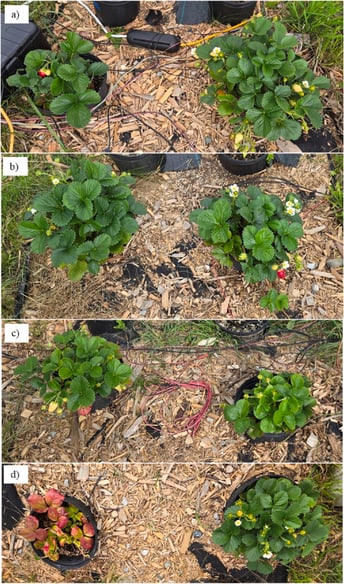Jun 25, 2025
Can Solar Panels Help You Grow Better Strawberries? A New Study Says Yes
How combining solar energy with strawberry farming could change the game for farmers, consumers, and the planet
Imagine a future where your strawberries grow beneath solar panels, soaking in just the right amount of light while your farm generates clean electricity at the same time. Sounds like science fiction? It’s not. A recent study from Ontario, Canada shows that growing strawberries under semi-transparent solar panels, a system known as "agrivoltaics", can actually boost fruit production, reduce costs, and generate energy.
At Agritecture, we’re always on the lookout for innovative approaches to Controlled Environment Agriculture (CEA), and this research is a great example of what happens when technology and farming come together with purpose.
What Is Agrivoltaics?
Agrivoltaics is a farming approach that places solar panels above crops, letting farmers produce food and energy from the same piece of land. It’s a win-win concept:
- You get electricity from the sun.
- Your crops are protected from extreme heat.
- Your land works twice as hard without expanding its footprint.
This approach is already being explored for a variety of crops, but strawberries—a delicate, high-value fruit—pose unique challenges and opportunities.
The Study Setup: Strawberries Under Solar Panels
Researchers in Ilderton, Ontario tested how strawberries grew under two different types of semi-transparent solar panels:
- Cadmium telluride (Cd-Te) thin-film panels – These provide even, uniformly distributed light.
40 % and 70 % transparent thin film Cd-Te PV module racks.
- Crystalline silicon (c-Si) panels – These create striped patterns of light and shade due to alternating opaque and transparent parts within the module - non uniformly distributed lighitng.
|
44 % c-Si PV module rack. |
69 % transparent c-SI PV module rack. |
They compared these two designs to strawberries grown in an open field (control group) and monitored plant health, soil conditions, and fruit yield.
The Surprising Results
The big surprise? The strawberries grown under striped crystalline silicon panels performed the best. They produced 18% more fruit by weight than those grown in the open.
Why? Several reasons:
- The panels lowered soil temperature, which helped reduce heat stress.
- They increased soil humidity, reducing the need for frequent irrigation.
- The non-uniform light patterns may have stimulated plant growth more effectively than even shading.
Cd-Te panels also had benefits, but they didn’t deliver the same yield increase as the striped ones.
Strawberry plant growth under Cd-Te PV modules. a) Strawberry plants under 40 % Cd–Te (red) PV module, b) Strawberry plants under 70 % Cd–Te (green) PV module, c) Strawberry plants under 70 % Cd–Te (blue) PV module, and d) Strawberry plants under 70 % Cd–Te (red) PV module). (For interpretation of the references to color in this figure legend, the reader is referred to the Web version of this article.)
Better Yields, Lower Costs, More Revenue
The study didn’t just stop at plant sciences and engineering. The researchers also crunched the numbers. Here’s what they found:
- Farmers could make 2-3x more revenue by combining strawberry sales with solar energy income.
- The added electricity generation could help lower the retail price of strawberries by up to 25% for consumers.
- Altogether, a region converting to strawberry farmlands to strawberry agrivoltaics could generate tens of millions of dollars in additional value.
This is especially significant for regions facing high land costs, labor shortages, or unreliable electricity infrastructure. Agrivoltaics can help stabilize income while advancing climate goals.
What This Means for the Future of Farming
This study is more than just a cool science experiment—it points to a future where:
- Farms produce fresh food and clean energy at the same time.
- Consumers pay less for high-quality produce.
- Land use becomes more efficient, helping to protect natural ecosystems.
- Farmers become more resilient, especially in the face of rising energy and climate costs.
It also highlights the need to rethink how we design agrivoltaic systems. Not all solar panels are helpful for every crop type, and semi-transparent panels with non-uniform light distribution might offer the best of both worlds for strawberry farmlands.
Could This Work in Your Region?
While this research was done in Ontario, the implications stretch far beyond Canada. The benefits of agrivoltaics could apply anywhere, where strawberries or similar crops are grown—from California and Spain to Kenya and Japan. However, success will depend on:
- Local climate and sunlight conditions
- Crop type and growth requirements
- Panel design and transparency
- Policy support and grid access
That’s where companies like Agritecture come in. We help assess feasibility, model yields, and optimize design for specific locations and markets.
Final Thoughts
Strawberries under solar panels may sound like a novelty, but this new research makes it clear: agrivoltaics is not just possible, it's profitable, productive, and sustainable.
By choosing the right solar design, farmers can grow more, earn more, and waste less—all while helping build a clean energy future.
We’ll be keeping an eye on this space and sharing more insights as agrivoltaics expands. If you’re a grower, policymaker, or technologist interested in this frontier, get in touch with us at Agritecture. The future of farming is looking bright—literally.
